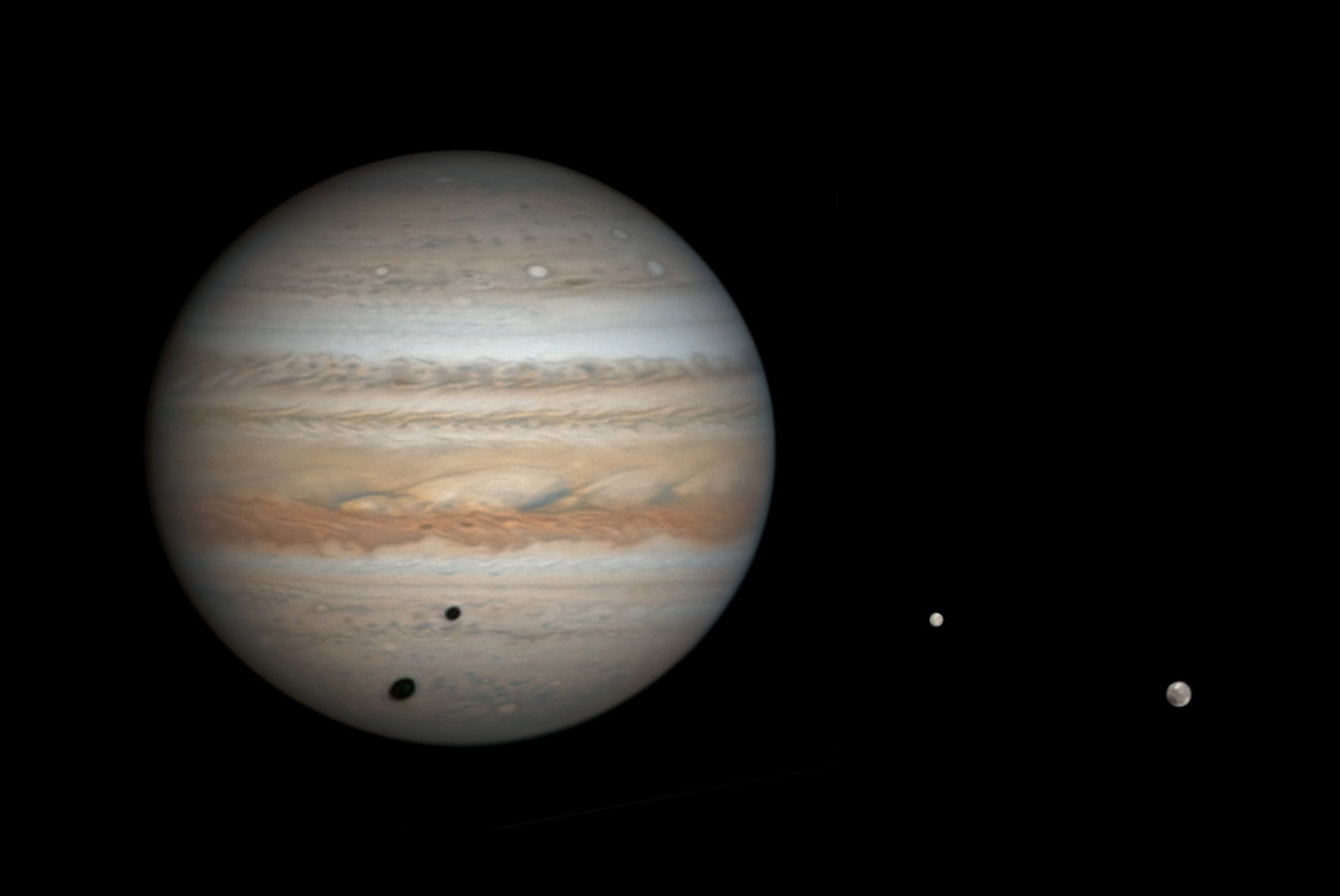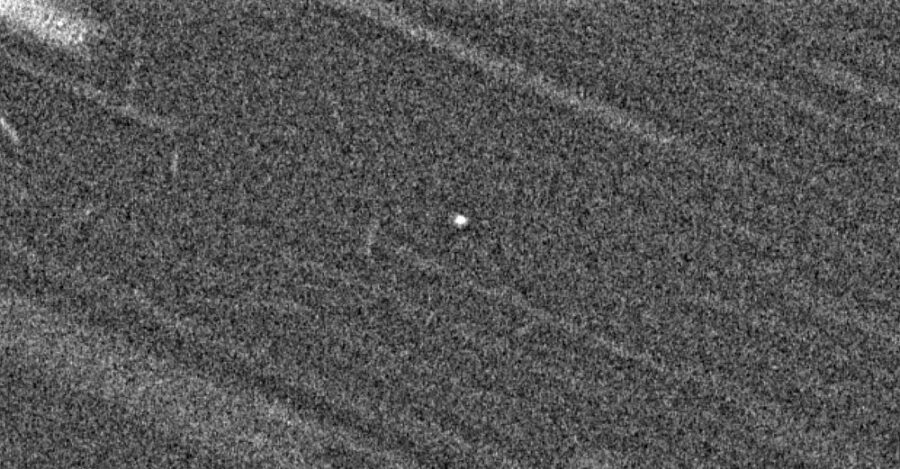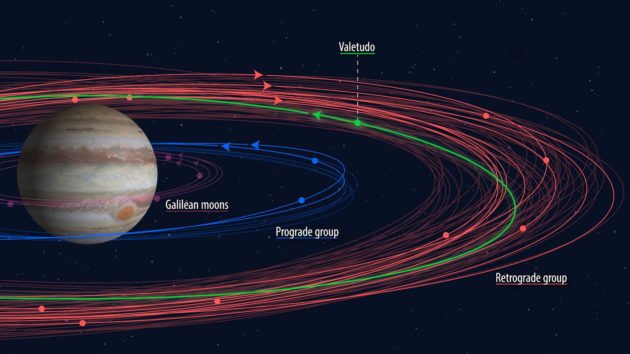New detections of candidate moons suggest that the king of planets could have hundreds of smaller satellites.

Damian Peach
Jupiter could have some 600 moons measuring at least 800 meters (2,600 feet) in diameter, according to a team of Canadian astronomers. They will present their findings on September 25th at the virtual Europlanet Science Congress 2020. Most of the moons are in wide, irregular, and retrograde orbits.
Over the past 20 years, astronomers have found dozens of small Jovian moons thanks to the advance of large digital cameras. Back in 2003, Scott Sheppard (Carnegie Institution of Science) already estimated that the number of irregular moons larger than a kilometer would probably be around one hundred.
Now, Edward Ashton, Matthew Beaudoin, and Brett Gladman (University of British Columbia, Vancouver) have detected about four dozen possible new Jovian moons that are even smaller. Extrapolating from the sky area they have searched (about one square degree), they conclude that there could be some 600 of these tiny objects orbiting the giant planet.
The team studied 60 archival 140-second exposures of a field close to Jupiter, all of them taken within a 3-hour period on September 8, 2010, with the 340-megapixel MegaPrime camera at the Canada-France-Hawai‘i Telescope on Mauna Kea. The astronomers digitally combined the images in 126 different ways, one for every possible combination of speed and direction at which a potential Jovian moon might move across the sky.

Edward Ashton (University of British Columbia)
This method revealed 52 objects down to magnitude 25.7, corresponding to diameters of some 800 meters. Seven of the brighter finds turned out to be known irregular satellites of Jupiter; the others are almost certainly retrograde Jovian moons, which orbit the planet in the direction opposite its rotation. A paper describing the results has been accepted for publication in The Planetary Science Journal (full preprint available here).
If this sensitive one-square-degree “pencil-beam” search already yields 45 formerly unknown moons, the researchers estimate that the total number of satellites within this size range must be around 600. The current official number of Jovian moons is 79.
Sheppard (whose team found 20 new satellites of Saturn last year) is not surprised by the new result. “We used a similar shift and stack technique for our Jupiter moon discoveries that were announced in 2018,” he says. “In our paper, we also mentioned detections that we could not confirm as moons, because we didn’t observe them for the months and years required to reliably determine their orbits.”

Carnegie Inst. for Science / Roberto Molar Candanosa
Likewise, the Canadian team cannot yet claim new discoveries for their 45 new detections, let alone for the extrapolated 600. “It takes a lot of large telescope time to get reliable orbits for these very small and numerous moons,” says Sheppard, “so one has to decide if that is scientifically valuable.”
According to Ashton, there are currently no plans for follow-up observations of the new moons. “It would be nice to confirm them,” he says, “but there is no way to track them without starting from scratch.” However, the tiny moons will certainly be found again by future instruments like the Vera C. Rubin Observatory. “They will then be linked back, so our observations will eventually be incorporated.”
The new detections raise the question of how small an object can be and still be called a moon. “Eventually one descends to ring particles, and some kind of cutoff will be useful,” says Ashton. But Sheppard doesn’t believe we need “any more definition of what is a moon.” Anyway, he says, the International Astronomical Union will not name planetary moons smaller than one kilometer in size.
 5
5









Comments
Andrew James
September 9, 2020 at 6:56 pm
Heaven help us and the IAU naming or deciding ID tags for them all.
Also. Using and calculating Roman numerals this high will be just as challenging as finding the moons or moonlets as well.
Looking forward to satellites like DLXXXVIII [588], DXC [590] and DC [600]. DXCVI [594] is paticularl nice as it has five different letters.
You must be logged in to post a comment.
Yaron Sheffer
September 21, 2020 at 9:06 am
Ha! So true. And this is just the tip of the iceberg.
Next we will be finding exomoons orbiting exoplanets. Who will name those? Do we really have the right to name objects in exosolar systems? Would the exonatives there object or agree to us naming their properties?…
PS. DXCVI is really [596] 😉
You must be logged in to post a comment.
Kenneth-Rumstay
September 11, 2020 at 5:34 pm
In my freshman astronomy class in 1971, we were expected to know the names of all the planetary satellites. But there were only 32 then.
You must be logged in to post a comment.
Dave
September 16, 2020 at 9:35 pm
"The new detections raise the question of how small an object can be and still be called a moon."-- Is there no formal definition of this?
You must be logged in to post a comment.
Ralf Kannenberg
October 13, 2020 at 10:27 am
"the International Astronomical Union will not name planetary moons smaller than one kilometer in size." Maybe they add the category of dwarf moons, then they can name them.
You must be logged in to post a comment.
You must be logged in to post a comment.